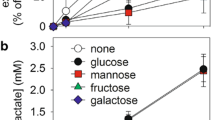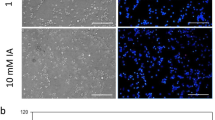We studied the sensitivity of a few reactions of thiamine metabolism in nerve cells upon the action of ethanol and acetaldehyde, as well as effects of the above-mentioned agents on vital capacity of cultured cells of different origins. Experiments were carried out on preparations of isolated nerve endings (synaptosomes), preparations of synaptosomal plasma membranes (SPMs), preparations of enzymes, and cell cultures. We estimated the ІС50 for the effects of ethanol and acetaldehyde on reactions that are the components of metabolism of the mobile thiamine pool in the cells. Ethanol in physiological concentrations inhibited the thiamine-binding activity of SPMs (ІС50 = 3.9 mM). At the same time, this agent used in the above concentrations practically did not influence the thiamine phosphate hydrolase activity of SPMs (estimated by the thiamine triphosphatase activity) and thiamine pyrophosphate kinase (TPK) activity. A product of ethanol metabolism, acetaldehyde, inhibited the thiamine triphosphatase activity with K і = 6.2 μM and the TPK activity with K і = 1.2 μM. The survival indices of cultured cells were estimated under conditions of the addition of ethanol and acetaldehyde to the medium. The cells of an astrocytic origin (line strain 1321 N1) and blood cells (line strain U937) practically did not respond to the presence of ethanol or acetaldehyde even in rather high concentrations in the culture medium. Under conditions of primary culture, neuron-like (differentiated) cultured РС-12 cells and also cerebellar granular neurons responded by significant decreases in the index of vital capacity to the addition of the above agents.
Similar content being viewed by others
References
Yu. M. Parkhomenko, Z. S. Protasova, and G. V. Donchenko, “Neuroactivity of thiamine: facts and hypotheses,” Ukr. Biokhim. Zh., 68, No. 2, 3-15 (1996).
А. Bâ, “Comparative effects of alcohol and thiamine deficiency on the developing central nervous system,” Behav. Brain Res., 225, 235-242 (2011).
М. Heroux et al., “Alterations of thiamine phosphorylation and of thiamine-dependent enzymes in Alzheimer’s disease,” Metab. Brain Dis., 11, No. 1, 81-88 (1996).
Khanh vinh quoc Lurong, Lan Thi Hoang Nguyen, “Thiamine and Parkinson’s disease,” J. Neurol. Sci., 316, 1-8 (2012).
А. Bâ, “Metabolic and structural role of thiamine in nervous tissues,” Cell. Mol. Neurobiol., 28, No. 7, 923-931 (2008).
J. H. Pincus, Y. Itokawa, and I. R. Cooper, “Enzyme inhibiting factor in subacute necrotizing enchephalomyelophathy,” Neurology, 19, No. 6, 841-845 (1969).
H. O. Nghiem, L. Bettendorff, and J. P. Changeux, “Specific phosphorylation of Torpedo 43K rapsyn by endogenous kinase (s) with thiamine triphosphate as the phosphate donor,” FASEB J., 14, No. 3, 543-554 (2000).
L. Bettendorff, “A non-cofactor role of thiamine derivatives in excitable cells?” Arch. Physiol. Biochem., 104, No. 6, 745-751(1996).
Y. M. Ostrovskiy, “On the mechanism of coenzymic and noncoenzymic action of thiamine,” Vitaminology, 14, 98-102 (1968).
B. Berman and R. A. Fishman, “Thiamine phosphate metabolism and possible coenzyme-independent function of thiamine in brain,” J. Neurochem., 24, No. 3, 457-465 (1975).
L. Bettendorff and P. Wins, “Thiamine diphosphate in biological chemistry: new aspects of thiamin metabolism, especially triphosphate derivatives acting other than as cofactors,” FEBS J., 276, No. 11, 2917-2925 (2009).
A. A. Sidorova (Strokina), S. P. Stepanenko, and Yu. M. Parkhomenko, “Characteristics of thiamine triphosphate associated with the plasma membranes of nerve cells,” Ukr. Biokhim. Zh., 81, No. 3, 57-65 (2009).
V. A. Postoenko, Yu. M. Parkhomenko, A. I. Vovk, et al., “Isolation and some properties of thiamine-binding protein of rat cerebral synaptosomes,” Biokhimiya, 52, No. 11, 1792-1797 (1987).
Yu. M. Parkhomenko, A. A. Strokina, S. Yu. Pilipchuk, et al., “The existence of two different active centers on thiamine-binding protein of synaptosomal plasma membranes,” Ukr. Biokhim. Zh., 82, No. 1, 34-41 (2010).
K. Chopra and V. Tiwari, “Alcoholic neuropathy: possible mechanisms and future treatment possibilities,” Br. J. Clin. Pharmacol., 73, No. 3, 348-362 (2012).
E. Rees and L. R. Gowing, “Supplementary thiamine is still important in alcohol dependence,” Alcohol Alcoholism, 48, No. 1, 88-92 (2013).
Yu. M. Parkhomenko, Z. S. Protasova, O. R. Yanchiy, et al., “Localization of thiamine-binding protein in synaptosomes from the rat brain,” Neurophysiology, 33, No. 3, 135-139 (2001).
Yu. M. Ostrovskii, “Thiamine,” in: Experimental Vitaminology, Yu. M. Ostrovskii (ed.), Nauka Tekhnika, Minsk (1979), pp. 176-223.
S. Yu. Pilipchuk, Yu. M. Parkhomenko, Z. S. Protasova, et al., “Interaction between thiamine kinase of the rat brain and thiamine and thiamine derivatives,” Ukr.Biokhim. Zh., 73, No. 2, 51-57 (2001).
S. A. Chornyy and Y. M. Parkhomenko, “Comparative characteristic of action of thiamine antagonists as apoptosis inducers in different types of nerve cells,” Ukr. Biokhim. Zh., 80, No. 5, 76-84 (2008).
V. K. Kibirev, T. V. Osadchouk, O. B. Vadzyuk, et al., “Examination of derivatives of 5-amino-4-acylamino-1Н-pyrazole as furin inhibitors,” Ukr. Biokhim. Zh., 83, No. 1, 30-37 (2011).
Y. M. Parkhomenko, P. A. Kudryavtsev, S. Y. Pylypchuk, et al., “Chronic alcoholism in rats induces a compensatory response preserving brain thiamine diphosphate, but the brain 2-oxo acid dehydrogenases are inactivated despite unchanged coenzyme levels,” J. Neurochem., 117, No. 6, 1055-1065 (2011).
H. Begleiter and B. Kissin, The Pharmacology of Alcohol and Alcohol Dependence, Oxford University Press, New York (1996).
K. N. Boyd, T. K. O’Buckley, and A. L. Morrow, “Role of acetaldehyde in ethanol-induced elevation of the neuroactive steroid 3alpha-hydroxy-5alpha-pregnan-20-one in rats,” Alcohol. Clin. Exp. Res., 32, 1774-1781 (2008).
Author information
Authors and Affiliations
Corresponding author
Rights and permissions
About this article
Cite this article
Parkhomenko, Y.M., Donchenko, G.V., Chornyi, S.A. et al. Thiamine Metabolism in Neurons and Their Vital Capacity Upon the Action of Ethanol and Acetaldehyde. Neurophysiology 46, 1–9 (2014). https://doi.org/10.1007/s11062-014-9399-4
Received:
Published:
Issue Date:
DOI: https://doi.org/10.1007/s11062-014-9399-4




